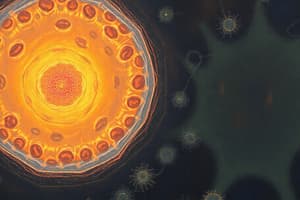Podcast
Questions and Answers
What is the primary role of the plasma membrane in a eukaryotic cell?
What is the primary role of the plasma membrane in a eukaryotic cell?
- Assists in protein synthesis
- Facilitates energy production
- Stores genetic material
- Acts as a selective barrier (correct)
Which component is responsible for energy production in eukaryotic cells?
Which component is responsible for energy production in eukaryotic cells?
- Ribosomes
- Endoplasmic reticulum
- Mitochondria (correct)
- Nucleus
Which of the following is true regarding prokaryotic cells?
Which of the following is true regarding prokaryotic cells?
- They typically have a single, circular DNA molecule (correct)
- They contain a nucleus
- They are always larger than eukaryotic cells
- They possess membrane-bound organelles
What distinguishes eukaryotic cells from prokaryotic cells?
What distinguishes eukaryotic cells from prokaryotic cells?
What role does the nucleolus play within the nucleus of a eukaryotic cell?
What role does the nucleolus play within the nucleus of a eukaryotic cell?
How does compartmentation benefit eukaryotic cells?
How does compartmentation benefit eukaryotic cells?
What cellular structure is primarily involved in protein and lipid synthesis?
What cellular structure is primarily involved in protein and lipid synthesis?
Which statement about cell theory is correct?
Which statement about cell theory is correct?
What is the primary purpose of the cell cycle?
What is the primary purpose of the cell cycle?
Which of the following correctly describes apoptosis?
Which of the following correctly describes apoptosis?
Which molecule is primarily involved in forming the cell membrane?
Which molecule is primarily involved in forming the cell membrane?
What is a characteristic difference between prokaryotic and eukaryotic cells?
What is a characteristic difference between prokaryotic and eukaryotic cells?
Which type of organism is composed of a single cell capable of performing all life functions?
Which type of organism is composed of a single cell capable of performing all life functions?
What is the primary role of DNA replication?
What is the primary role of DNA replication?
Which type of bacteria thrive best at high temperatures?
Which type of bacteria thrive best at high temperatures?
Which of the following cellular functions is essential for energy production?
Which of the following cellular functions is essential for energy production?
What type of bacteria do not require oxygen for growth?
What type of bacteria do not require oxygen for growth?
In which phase of the cell cycle does DNA replication occur?
In which phase of the cell cycle does DNA replication occur?
Which type of bacteria can thrive in acidic environments?
Which type of bacteria can thrive in acidic environments?
What role do carbohydrates primarily serve in cells?
What role do carbohydrates primarily serve in cells?
What distinguishes animal cells from bacterial cells?
What distinguishes animal cells from bacterial cells?
What is a function of cell signaling in multicellular organisms?
What is a function of cell signaling in multicellular organisms?
Flashcards
What is cell biology?
What is cell biology?
Study of cells, their structure, function, and internal processes.
What is a cell?
What is a cell?
The smallest unit of life capable of independent function.
What are prokaryotic cells?
What are prokaryotic cells?
Simple cells without a nucleus or membrane-bound organelles.
What are eukaryotic cells?
What are eukaryotic cells?
Signup and view all the flashcards
What is the plasma membrane?
What is the plasma membrane?
Signup and view all the flashcards
What is the cytoplasm?
What is the cytoplasm?
Signup and view all the flashcards
What is the nucleus?
What is the nucleus?
Signup and view all the flashcards
What are organelles?
What are organelles?
Signup and view all the flashcards
Cell Division
Cell Division
Signup and view all the flashcards
Cell Cycle
Cell Cycle
Signup and view all the flashcards
G1 Phase
G1 Phase
Signup and view all the flashcards
S Phase
S Phase
Signup and view all the flashcards
G2 Phase
G2 Phase
Signup and view all the flashcards
M Phase
M Phase
Signup and view all the flashcards
Unicellular Organisms
Unicellular Organisms
Signup and view all the flashcards
Multicellular Organisms
Multicellular Organisms
Signup and view all the flashcards
Tissues
Tissues
Signup and view all the flashcards
Organs
Organs
Signup and view all the flashcards
Organ Systems
Organ Systems
Signup and view all the flashcards
Apoptosis
Apoptosis
Signup and view all the flashcards
Necrosis
Necrosis
Signup and view all the flashcards
Prokaryotic Cells
Prokaryotic Cells
Signup and view all the flashcards
Eukaryotic Cells
Eukaryotic Cells
Signup and view all the flashcards
Study Notes
Introduction to Cell Biology
- Cell biology studies cells, their structure, function, and internal mechanisms.
- Cells are the fundamental units of living organisms.
- Two main cell types exist:
- Prokaryotic cells: Lack a nucleus and membrane-bound organelles, simpler structures.
- Eukaryotic cells: Contain a nucleus and membrane-bound organelles, more complex structures.
Key Components of a Eukaryotic Cell
- Three main regions:
- Plasma membrane: Outer boundary, selectively permeable.
- Cytoplasm: Fluid-filled interior, contains organelles and cytosol.
- Nucleus: Contains DNA, controls cellular activities, and protein synthesis.
Plasma Membrane
- A selective barrier, regulating what enters and exits the cell.
- Composed of lipids, proteins, and carbohydrates.
Cytoplasm
- A fluid-filled space within the cell, containing organelles and cytosol (the gel-like substance).
- Organelles are specialized structures with specific functions.
Nucleus
- Contains the cell's DNA.
- Controls cellular activities, including protein synthesis.
- Contains a nucleolus, site of ribosome assembly.
Function and Characteristics of a Prokaryotic Cell
- Smaller than eukaryotic cells, simpler structures.
- Lack a nucleus and membrane-bound organelles.
- Genetic material is usually a single, circular DNA molecule in the nucleoid region.
- Prokaryotes are self-sufficient; they can:
- Multiply
- Produce energy (e.g., ATP synthesis)
- Send and receive signals
- Move
- Microscopic in size and are the most abundant cell type.
The Importance of Cellular Compartmentation
- Compartmentation allows for efficient and specialized functions within cells.
- Eukaryotic compartmentalization increases cellular complexity and organization.
Cellular Components
- Organelles are organized compartments with specific functions.
- The nucleus directs cellular activities, including protein synthesis.
- The endoplasmic reticulum (ER) is involved in protein and lipid synthesis.
- Mitochondria produce energy via cellular respiration.
- Lysosomes break down cellular waste and debris.
Cell Theory
- All living things are made up of one or more cells.
- Cells are the fundamental units of life, possessing the characteristics necessary for life.
- New cells arise from pre-existing cells through cell division.
- Cells are the smallest units considered living.
Cell Division and the Cell Cycle
- Cell division is crucial for growth, repair, and reproduction.
- The cell cycle describes the events from cell formation to division.
- Four phases:
- G1 (Gap 1): Cell growth, carrying out normal functions.
- S (Synthesis): DNA replication occurs.
- G2 (Gap 2): Preparation for cell division.
- M (Mitosis): Cell division.
Importance of the Cell Cycle
- Enables growth and development in multicellular organisms.
- Allows repair of damaged tissues.
- Enables sexual reproduction.
Key Differences Between Prokaryotic and Eukaryotic Cells
- Nucleus: Prokaryotes lack, eukaryotes have.
- Organelles: Prokaryotes have few, eukaryotes have many.
- Genetic material: Prokaryotes have circular DNA, eukaryotes have linear DNA.
- Size: Prokaryotes are generally smaller than eukaryotes.
Cellular Composition
- Cells primarily consist of water, proteins, lipids, and carbohydrates.
- These molecules are organized into structures for specific functions.
- Amino acids create proteins with diverse cell functions.
- Lipids (phospholipids) form cell membranes.
- Carbohydrates provide energy and structural support.
Cellular Functions
- Cells perform crucial functions like:
- Cellular respiration: Converting food into energy.
- Protein synthesis: Creating proteins.
- DNA replication: Copying DNA.
- Cell signaling: Communicating between cells.
Cell Communication
- Cells communicate via signals.
- Signal transduction pathways transmit information between cells.
- Essential for coordinating cellular activities and tissue function.
Death of a Cell
- Apoptosis: Programmed cell death, crucial for development and removing damaged cells.
- Necrosis: Accidental cell death, caused by injury or insult.
Unicellular and Multicellular Organisms
- Unicellular organisms: Exist as a single, self-sufficient cell performing all life functions.
- Multicellular organisms: Consist of many specialized and interdependent cells.
Types of Multicellular Organizations
- Tissues: Groups of similar cells performing a shared function.
- Organs: Structures formed by different tissues working together.
- Organ systems: Groups of organs carrying out a complex bodily function.
The Importance of Studying Cell Biology
- Fundamentally understanding the basis of life.
- Developing new therapies for diseases.
- Advancing technologies like biotechnology.
- Investigating the origin of life.
Bacterial Shapes
- Bacteria can be spherical (coccus), rod-shaped (bacillus), or spiral (spirillum).
Essential Needs for Bacterial Survival and Multiplication
- Nutrients: Fundamental elements (carbon, hydrogen, oxygen, nitrogen, phosphorus, sulfur) for survival.
- Energy Source: Light (phototrophs) or chemical compounds (chemotrophs) power bacterial functions.
- Carbon Source: Bacteria need carbon to build organic molecules. Autotrophs synthesize organic compounds from inorganic materials. Heterotrophs obtain organic carbon from pre-existing organic matter.
- Growth Factors: Certain molecules (amino acids, vitamins, hormones) bacteria require but cannot synthesize.
Bacterial Classification Based on Temperature Tolerance
- Thermophiles: Thrive in high temperatures (40-55°C).
- Mesophiles: Prefer moderate temperatures (20-40°C).
- Psychrophiles: Thrive in cold temperatures (typically below 20°C).
Bacterial Classification Based on pH Tolerance
- Acidophiles: Prefer acidic environments (pH 4 or lower).
- Basophiles: Survive in alkaline environments (pH 8-11 or higher).
- Neutrophiles: Thrive in neutral pH environments (around 7).
Bacterial Classification Based on Oxygen Requirements
- Strict Aerobes: Require oxygen for survival.
- Anaerobes: Cannot tolerate oxygen.
- Microaerophiles: Require small amounts of oxygen.
- Facultative Anaerobes: Can thrive with or without oxygen.
Key Differences Between Animal and Bacterial Cells
- Cell Wall: Animal cells lack a cell wall; bacterial cells have one.
- Nucleus: Animal cells have a true nucleus; bacterial cells have a nucleoid region.
- Organelles: Animal cells have membrane-bound organelles; bacterial cells do not.
- Size: Bacteria are typically much smaller than animal cells.
- Reproduction: Bacteria reproduce asexually (binary fission); animal cells reproduce sexually (mitosis/meiosis).
- Genetic Material: Bacteria have a single, circular chromosome; animals have multiple, linear chromosomes.
Studying That Suits You
Use AI to generate personalized quizzes and flashcards to suit your learning preferences.




